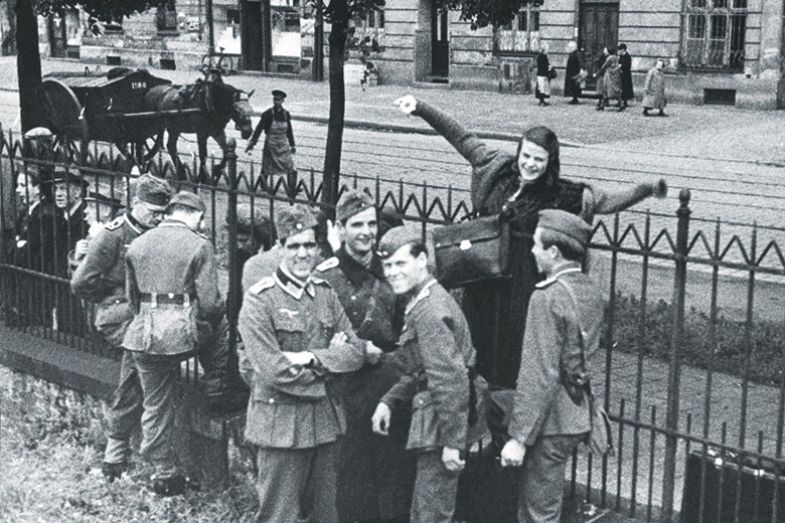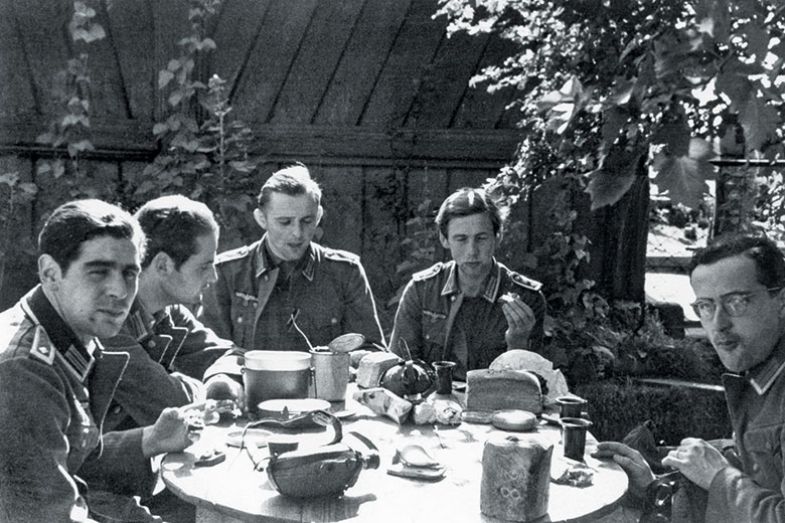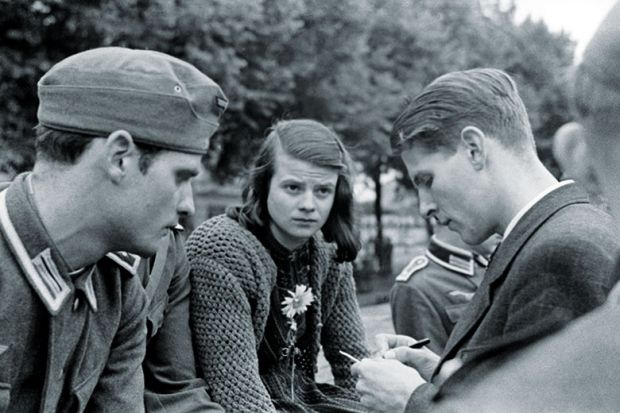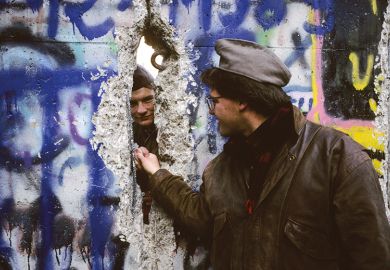In towns and villages around the world, periodic commemorations arouse people to contemplate moments in history that, as we promise ourselves, must never be permitted to happen again. Among the more significant of these is the one held annually at the main entrance of LMU Munich.
This commemorates the White Rose, the non-violent German resistance movement whose untimely demise at the hands of the Gestapo occurred 75 years ago this year. Led by students from the university, the White Rose produced and distributed six remarkable pamphlets denouncing the Nazi regime and urging their fellow citizens to oppose it, before the group’s principal members were arrested and executed in 1943, just eight months into their campaign.
This tragic yet inspiring story has become well known around the world, but it is at LMU Munich that its legacy is most cherished. Since the end of the Second World War, the university has hosted a permanent White Rose exhibition and an annual memorial lecture.
A stylised white rose is also set into the paving at its main entrance (pictured above), in Hans and Sophie Scholl Square (Geschwister-Scholl-Platz). Created by the sculptor Robert Schmidt-Matt, the flower is made up of various documents produced by the movement’s protagonists, including a pamphlet that was taken to the UK, reproduced in millions and dropped by the RAF across Germany after their executions. Sophie Scholl, the 21-year-old biology and philosophy student who is the most immediately recognisable face of the resistance movement, instinctively chose the rose as the emblem of the resistance, seeing in it a symbol of human nature.
In a 2015 article, New York Times writer Anna Sauerbrey suggested that “instead of trying to transfer a vague feeling of guilt to yet another generation” – in other words, she might have added, periodically soothing the sense of shame while singing hymns and citing facts – “we should change from remembering what we must never forget to knowing why”. Her attempt to understand what it is that drives people to commit the unthinkable thankfully skirted the tired refrain that history has lessons to teach.
In these increasingly disquieting times, such history deserves serious attention – not least from students, to whom such desperate events seem increasingly remote, even as they evidently slip back into public consciousness. Are there any who would respond with the bravery and humanity shown by Sophie and her brother Hans, alongside fellow students Alexander Schmorell, Willi Graf and Christoph Probst, as well as LMU professor of philosophy and musicology, Kurt Huber ?
A classic photograph shows Sophie in a gesture of spontaneous affection as she reaches out to embrace the group. Anyone familiar with her letters and her diaries – indeed her behaviour towards those with whom she worked, notably those in authority – could not possibly mistake the integrity implicit in her gesture, her eyes, her smile. It is 1942 – summer, to judge by the agreeable weather – and Hans and his mates are in army uniform at the Ostbahnhof, Munich’s eastern railway station, preparing to leave for Russia. However relaxed the lads appeared, the business on their horizon was of a deadly serious nature, in whichever direction they dared to look. That calm facade also conceals the exceptional courage in the service of their country that has come universally to define their actions and legacy.
But would courage alone, as ordinarily understood, have sufficed to distinguish the young men from the corrupt system that had delivered them here? There is reason for doubt.
Coming as it does in many shapes and sizes, courage could be thought of as a function of discipline, but with no assurance that it will not miscarry at the decisive moment – as happened in 1944 with the failed plot against Hitler’s life. The urge to compete and outshine was intrinsic to the camping, hiking, games and other invigorating activities in which young Germans of the 1930s were compelled to take part, save for the enforced exception of Jews. Participation fast-tracked a cunning path from conformity to fanaticism, via excitement and passion. All of which shared a home behind a pretence of courage. The Hitler Youth was its name.
Necessary when White Rose members went off to distribute their defiant leaflets in distant places was courage of another dimension altogether. Customarily they travelled alone, late at night and by rail, exposed to spontaneous police inspections, demands for identity documents and questions designed to intimidate. Often they would be forced to extemporise answers that would explain their presence in places where they lacked permission to be. Scrutiny, suspicion and punishments increased exponentially, clearly noticeable after the disaster at Stalingrad, as Germany’s deteriorating military situation became public knowledge. The chance of arrest existed with each word spoken: even a tone of voice or facial expression could be misconstrued. Courage was internalised and invisible; fear was a fact of life.
But such was the case for anyone in those days out in the streets or on the trams, or simply going about the daily ordeal of coping behind closed doors. There were considerable completely unheralded examples of nominally passive resistance among everyday Germans, whether taking cover in protest when Brownshirts were on the march or defacing prominent memorials such as Munich’s Loggia. These were people seldom lacking in what commonly passes for courage. They, too, risked execution for their troubles.
What, therefore, explains the phenomenon of the White Rose, proclaimed where other similar attempts on the system have increasingly been relegated to footnotes of history – including even the generals’ plot against Hitler, whose conspirators boasted such prominent names as the aristocratic Claus von Stauffenberg and, probably, the “Desert Fox” himself, Erwin Rommel.

Courage – but with a singular twist – was exhibited by Alexander Schmorell, a name as much to be extolled as anyone’s in this notable tale. Posted to the Eastern front, the 25-year-old Russian-born medical student had long since rejected the indoctrinations endured during his days with the Hitler Youth. How otherwise to describe the occasion when, out of sheer compassion for another human being, he offered a young Jewish girl in distress his partly eaten rations? Had he been discovered by his politically obsessed colleagues in such an overt act of kindness, he would have been summarily shot.
Wanting nothing to do with anyone wearing the feared German uniform, the unfortunate girl let the food drop to the ground. Awake to her sensitivities, he decided on an even more dramatic token of his convictions. Reaching for a nearby flower and placing it with what he could rescue of his food, he made another attempt. This time, she accepted. Whereupon he turned to board the train that would return him to Germany.
Looking around to catch a final sight of her, he was astounded by the image that greeted him. There she stood, clutching her flower – the food almost incidental – and gesturing in mute acknowledgement of compassion so utterly unexpected under the circumstances. His simple gesture, it was clear, had struck a deep chord. Were evidence ever needed of altruism crossing barriers of distance, class, uniform and politics, here it is.
In Lewis Milestone ’s 1930 film adaptation of All Quiet on the Western Front, Erich Maria Remarque’s reflection on war, a soldier is observed during a brief lull in battle during the First World War. He reaches out caringly to shield a passing butterfly from harm, protecting its fragile beauty. A concealed enemy sniper is simultaneously observed taking deadly aim. How very evocative of a rose and its thorns! The film’s genius emphasises the power of silent image and inherent message – omnipresent in good books, the arts and experience of nature, but too often too little understood, even by university academics.
But the members of the White Rose group would have been alive to such messages. In her diary, Sophie Scholl expresses her sense of spiritual well-being “when I turn my head [and] my cheek grazes the rough trunk of the apple tree next to me. How protectively it spreads its good branches over me…The sap rises from its roots, nurturing even the smallest leaves.” Here, clearly, is an evocation of the positive influence that she felt her betters exerted upon her: particularly that of her parents, whose experience and superior knowledge were shared even among the family’s smallest members, but also beyond. To judge by their offspring, Magdalene and Robert Scholl must have been outstanding parents.
Of his own parents, Schmorell’s nephew, Markus, recalls “their freethinking worldview and the enlightened respect that they had for their fellow human beings”. His father especially possessed the remarkable characteristic of “treating everyone without any sense of discrimination, encountering all with the same unfailing spirit of goodwill – in fact, I should really say spiritually”.
This, then, was a pattern that, established early in life, stimulated the learning and wisdom that the Scholls and the colleagues they were to enlist to the cause sought out for themselves as they matured at LMU Munich. Instances would be found among the wide range of books, art and music they preferred and those with whom they shared similar attitudes towards life, and by whom they would have expected their individual beliefs and attitudes to be challenged. This is as much to say that they all responded to the notion of culture – which, according to Markus, “has new meaning with each new day; to help us better observe and tell, to remember and forget, we study Homer, Turgenev, Zweig, Kafka, Sebald and Beckett”.
Such thinking, strongly held and enlightened – revolutionary, in fact – helped to decide the early and violent fate of the White Rose members. But it is exactly the thinking that illustrates the connection between learning, wisdom and goodness that has been proclaimed since ancient times and that universities have sought, with greater or lesser success, to embody and to impress upon their students.

As the final curtain was coming down on this tragedy, it is perhaps not surprising that little was recorded of the walk-on players. Some deserve mention, however. They were close witness to the prisoners’ commendable bearing, whether enduring the feared Gestapo interrogations or, thereafter, in court and finally at Stadelheim, the prison where they awaited execution.
Having observed with sympathy – a virtue not customarily associated with the Gestapo – the poise and dignity with which she had responded to him, Sophie’s interrogator, Robert Mohr, caringly returned her to her cell. Here she was greeted by a welcome that, prepared contrary to the rules by her cellmate, Else Gebel, must have moved her to believe that White Rose was indeed making its mark. Prisoners and guards from every corner of the prison contributed what modest scraps of food and treats they possessed in a gesture of profoundest esteem evoked by the accounts that they had heard of the behaviour of Sophie and her family.
After the trial, the elder Scholls rushed to Stadelheim and, despite the regulations prohibiting it, talked their way into visiting their children. The prison’s staff, already in admiration of them, turned a blind eye, at considerable risk to themselves.
In fact, all who came anywhere near to the White Rose prisoners felt impelled by their evident courage and morality, but most of all by their faith. On the day of his execution, the medical student Christoph Probst wrote to his mother, with a maturity far beyond his 24 years: “Don’t be sad that I sprang over part of [life]. Soon I’ll be closer to you than ever. When I think about it, it’s the only way to God. I am dying without any hate.”
But it is Sophie, preternaturally sensitive, intelligent and modest, who could be said to best epitomise the movement. Her deeply affecting and memorable final words, as the guillotine’s blade was about to fall, speak volumes about White Rose. “How can we expect righteousness to prevail when there is hardly anyone willing to give himself up individually to a righteous cause?” she asked. “Such a fine, sunny day, and I have to go, but what does my death matter if, through us, thousands of people are awakened and stirred to action?”
Is it possible that a nation familiar to history for its belligerence can be transformed by the example of a handful of such unaffected students? Indeed, could it be argued that the success of Germany’s recent national election, the outcome of peaceful dialogue and compromise, might be attributed, at least in small part, to the White Rose effect?
“Broadly speaking,” Markus Schmorell reflects, “it is true that White Rose was not very widely known [at the time]. But, certainly, there were circumstances in which the resistance left its mark, unsung as it might have been in the moment.”
Students have typically been idealistic and more inclined than most to selflessness. But White Rose, a story of the largely commonplace yet eternal affairs of humanity, could be said to be the archetype. The world hopes that this particular strain of courage will never be required again. But, equally, we must hope that it is still to be found somewhere, somehow: in certain corners of modern campuses if nowhere else. Just in case.
Kenneth Asch is a freelance journalist. He studied music at LMU Munich and pursued an opera career at the Bavarian State Opera. He is also director of Peace and Commemoration, a project at the University of Oxford that examines the modern relevance of ancient Greek tragedy through words and music. It is due to be launched at the University of Helsinki later this year, before touring the Europaeum network of universities.
POSTSCRIPT:
Print headline: Courage under fire
Register to continue
Why register?
- Registration is free and only takes a moment
- Once registered, you can read 3 articles a month
- Sign up for our newsletter
Subscribe
Or subscribe for unlimited access to:
- Unlimited access to news, views, insights & reviews
- Digital editions
- Digital access to THE’s university and college rankings analysis
Already registered or a current subscriber?











